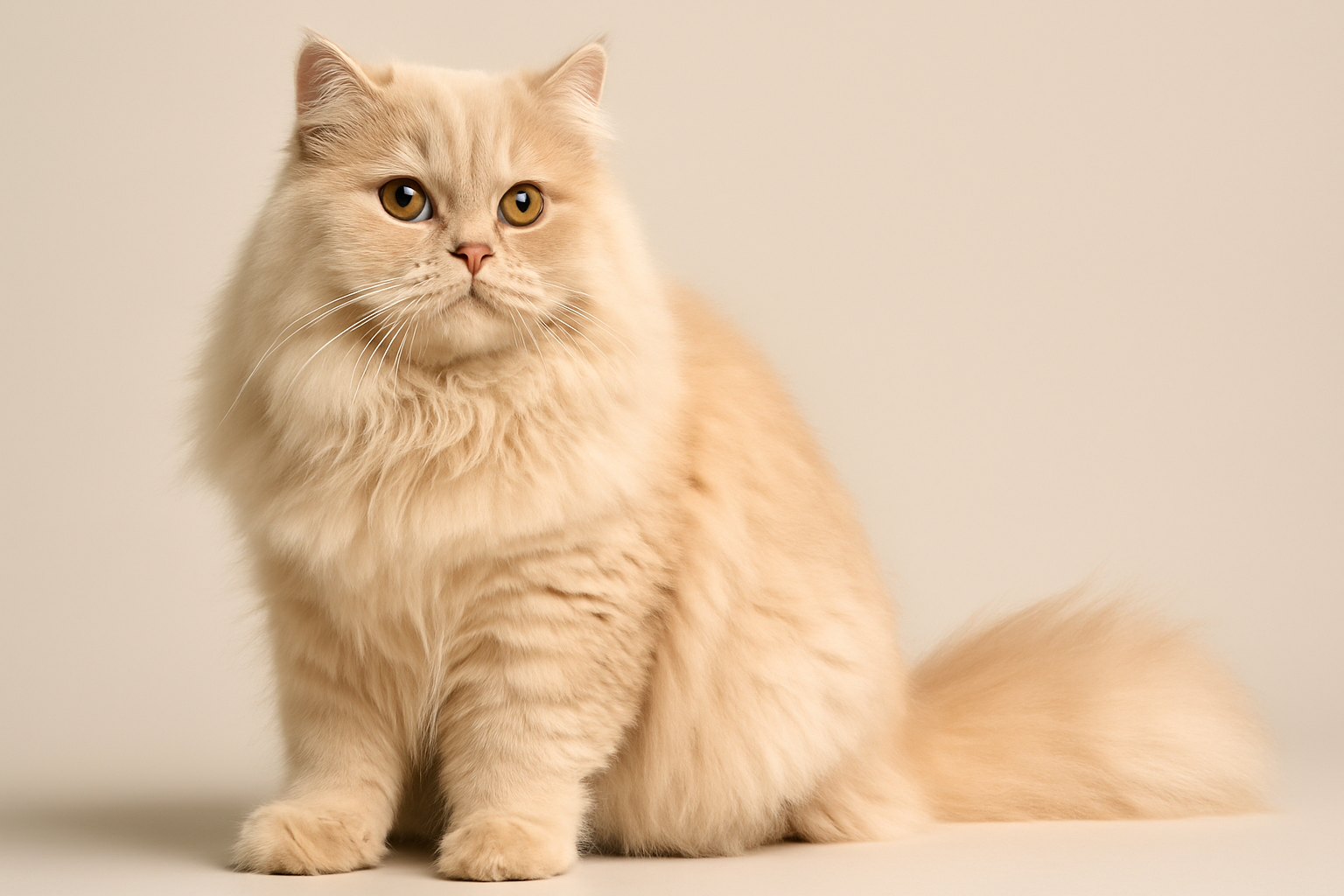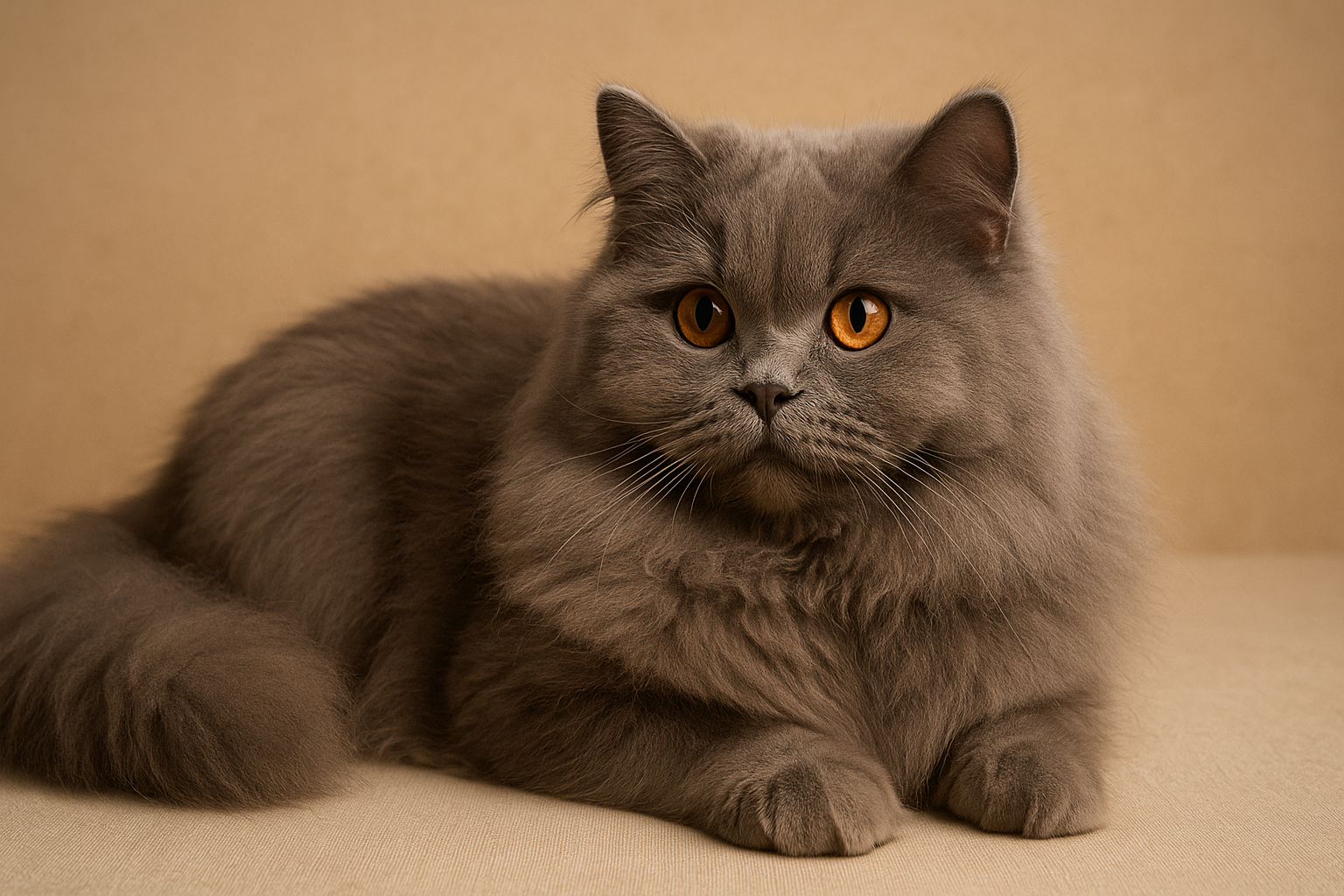If you’ve ever wanted a cat that looks like a living teddy bear, the British Longhair Cat might just steal your heart. With their round face, plush coat, and calm personality, these cats bring an irresistible mix of cuteness and charm into the home.
They’re often described as the long-haired cousins of the British Shorthair. You get the same sturdy body, laid-back nature, and soulful eyes—just wrapped in a luxuriously thick coat that makes them look extra huggable.
Quick Breed Facts
- Origin: United Kingdom
- Breed Registries: Recognized by GCCF and TICA; not accepted by CFA or FIFe
- Weight Range: 7–12 lb (Females); 9–17 lb (Males)
- Lifespan: ~12–16 Years
- Coat: Medium-Long, Plush Double Coat
- Colors & Patterns: Solid, Tabby, Bicolor, Colorpoint, Silver/Smoke, More
- Eye Color: Copper/Gold; Blue In Colorpoints; Green In Some Silvers
- Grooming: Moderate To High
- Activity Level: Low To Moderate
- Affection Level: Medium To High
- Vocality: Low
- Good With Children: Yes, When Respectful
- Good With Other Pets: Usually, With Slow Introductions
History & Origin
The British Longhair came about when breeders noticed some British Shorthairs carrying a hidden recessive long-hair gene. This gene had been introduced generations ago through careful outcrosses with long-haired cats. Over time, breeders began celebrating these fluffy kittens rather than treating them as an accident, and the British Longhair gradually earned recognition as its own variety in some registries.
Although not as universally famous as their shorthaired cousins, British Longhairs are gaining fans worldwide. Their appeal lies in the familiar British sturdiness, round features, and mellow personality—combined with a coat that makes them look especially majestic.
Personality & Temperament
British Longhairs are known for being gentle, steady companions. They’re not usually clingy, but they love being near you—content to nap on the sofa while you read, or curl up on a chair in your office while you work. They’re affectionate without demanding constant attention, which makes them easy to live with.
While they’re not chatterboxes, they do communicate with soft meows and expressive eyes. Families often describe them as “easy cats”—sweet-natured, polite, and adaptable. With respectful kids or calm pets, they’ll happily become part of the household rhythm.

Activity & Play
Though not as energetic as some breeds, the British Longhair still enjoys a bit of daily fun. Short bursts of play with a wand toy or feather teaser are usually enough to keep them active and engaged. They also enjoy puzzle feeders and window perches, where they can watch the world go by.
Don’t expect acrobatics or marathon zoomies—this breed prefers slow-paced entertainment over high-flying antics. Think of them as the dignified players of the cat world, happy to join in but just as happy to lounge and observe.
Grooming & Care
Their gorgeous double coat does require a bit of work. Aim for brushing three to four times a week, and daily during shedding seasons. This keeps mats away and reduces loose hair in your home. Most cats enjoy the routine if you start gently and reward them with treats or pets.
Alongside brushing, trim their nails every couple of weeks, keep up with dental care, and check their ears regularly. Because their fur is so plush, it’s worth keeping an eye on spots like the armpits and breeches where tangles sneak in.
Health & Lifespan
British Longhairs are typically healthy cats and often live between 12 and 16 years. Like their shorthaired relatives, they can be prone to hypertrophic cardiomyopathy (HCM), a heart condition seen in some pedigree breeds. Responsible breeders usually screen for this, so it’s always worth asking.
Weight management is another key part of their health. Because they’re not overly active, they can gain weight if overfed. Measured meals, interactive feeding, and gentle daily play help keep them at a healthy weight well into their senior years.
Family Compatibility
These cats are wonderful family companions. They get along with children who know how to handle pets respectfully and usually adapt well to multi-pet households when introductions are done slowly. Their patient, calm nature makes them a good fit for homes with steady routines.
If you’re looking for a cuddly companion who’s affectionate but not overwhelming, the British Longhair is an excellent choice. They bring a comforting presence to any home, whether it’s a lively family setting or a quieter household.
Nutrition
Feeding a British Longhair is all about balance. Choose a high-quality diet suited to their age and lifestyle, and don’t overdo the portions. They’re built solidly, so it’s easy to mistake them for being underfed when in reality they just have a naturally sturdy frame.
Wet food can help support hydration, while dry kibble adds convenience. Many families do a mix of both. Always provide fresh water, and consider a pet fountain if your cat prefers moving water—it often encourages them to drink more.
Recommended Supplies
Along with a sturdy litter box and clumping litter, invest in grooming tools that can handle their dense coat. A cat tree with broad, stable platforms gives them a cozy perch, while puzzle toys and soft beds round out their needs.
British Longhairs appreciate comfort and stability—so choose supplies that support a relaxed lifestyle. A comfy window perch or plush bed is often where you’ll find them snoozing away the afternoon.
Finding a British Longhair
If you decide to buy from a breeder, look for one who prioritizes health testing and transparency. A good breeder will happily answer questions and provide documentation. Kittens should be well socialized and raised in a home environment, not a cage.
Adoption is also an option. While rarer in shelters, British Longhairs do sometimes appear in rescue groups focused on long-haired or British-type cats. An adult British Longhair can be a particularly easy addition, as their personality is already developed.
Final Thoughts
The British Longhair Cat is truly the best of both worlds: the sturdy, gentle temperament of the British Shorthair, paired with a luxurious coat that invites cuddles. They’re affectionate without being clingy, playful without being demanding, and endlessly charming in their teddy bear-like appearance.
If you’re searching for a relaxed, loyal companion who will happily share your space and bring warmth to your home, the British Longhair could be your perfect match.
British Longhair Cat FAQs
Are British Longhair cats hypoallergenic?
No cat is completely hypoallergenic. Regular grooming and cleaning can help, but people with allergies may still react.
How often should I brush a British Longhair?
Brush at least three to four times weekly, and daily during heavy shedding seasons. It keeps mats away and reduces hairballs.
Do British Longhairs like to cuddle?
Yes—most enjoy quiet closeness and gentle petting. They’re sweet and affectionate but not overly needy.
What’s their typical lifespan?
With good care, they usually live 12 to 16 years, sometimes longer. Routine vet visits and a healthy diet go a long way.
Are they good with children and other pets?
Yes, they tend to be patient and gentle. With respectful children and slow introductions to other pets, they fit in well.






